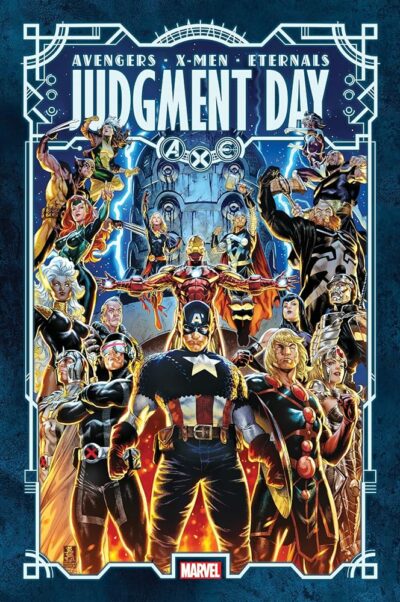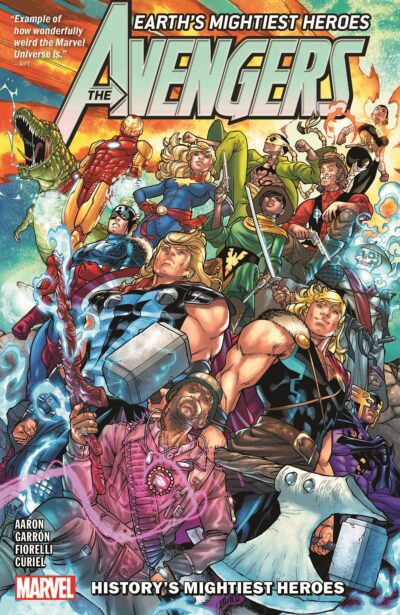To view this content, you must be a member of Peter's Patreon at $1.99 or more
Already a qualifying Patreon member? Refresh to access this content.
Comic Books, Drag Race, & Life in New Zealand
Today is a historic day in modern comics history, so it’s also a big day for Pledgeonaut Patrons of Crushing Krisis! That’s because one of the longest-dangling plot threads in comics has been tied up neatly with one of today’s new releases. The more I thought about it and got curious about it, the more I realized that no one else on the internet would approach explaining it quite like I would. And that is how I wound up spending my week creating a Guide to Miracleman!
Today’s historic event is the release of Miracleman by Gaiman & Buckingham: The Silver Age (2022) #7. Aside from being a mouthful, today’s issue is the final installment of the middle “book” of Gaiman & Buckingham’s planned trilogy of Miracleman arcs. Why all the fuss about a middle chapter? Because they started that middle chapter in June 1992, and for nearly two decades it seemed like they would never have the chance to finish it.
[Read more…] about Guide to Miracleman & Marvelman – New for Patrons!
It’s the third new comic book day of the new year! This post covers Marvel Comics January 17 2024 releases. Missed last week’s releases? Check out last week’s post covering Marvel’s January 10 2024 releases.
This week in Marvel Comics: Gaiman & Buckingham close a chapter of Miracleman, Nicieza returns to Cable, and an omnibus of Gillen’s almost-perfect Marvel event!
This list includes every comic and digital comic out from Marvel this week, plus collected editions in omnibus, hardcover, paperback, and digest-sized formats. For each new release, I’ll point you to the right guide within my Crushing Comics Guide to Marvel Comics to find out how to collect each character in full – and, if a guide is linked from this post, that means it is updated through the present day!

The Amazing Spider-Man Epic Collection, Volume 27: The Clone Saga
(2024 paperback, ISBN 978-1302953669 / digital)
See Guide to Spider-Man, Peter Parker (1963-2018). For many years we’ve assume that the Epic line would cut off prior to the Clone Saga in Amazing Spider-Man, if only because there are already a well-mapped set of “Epic” collections for this period across the Spider-line. Well, guess what? Marvel generally follows the Disney rule that it’s always a good idea to re-release popular material every 7-10 years, and that’s how long it has been since the last set of paperback reprints! It’s unclear right now if the Epic line will collect this period as comprehensively as the prior paperbacks or the omnibuses. This stretches a bit farther than I’d expect in Amazing Spider-Man if it was going to collect everything that ran alongside it, but we’ll need to see a Volume 28 to be certain.
Avengers: Beyond
(2024 paperback, ISBN 978-1302952044 / digital)
See Guide to Avengers Flagship Titles (2010 – Present). This collects a fun, five-issue Derek Landy & Greg Land series with ties to the original Secret Wars that follows up on their All-Out Avengers (2022) #1-5. All-Out was much more fun with its one-off issues, whereas this is one continuous story. For me, more of a “read it digital” than “buy it.”
The Incredible Hulk Vol. 1: Age of Monsters
(2024 paperback, ISBN 978-1302954161 / digital)
See Guide to Hulk – Bruce Banner. I can’t say that I’m a fan of this Phillip Kennedy Johnson run on Hulk, though it looks great thanks to Nic Klein’s artwork. The majority of Phillip Kennedy Johnson comics include domestic abuse, sexual assaults, and threats of sexual violence – all largely against women, even if it’s just offhand comments or background action. When I’m looking for consistency from a writer, that’s not what I’m talking about.
A.X.E. Judgment Day Omnibus
(2024 oversize hardcover, ISBN 978-1302952907 / digital)
See Guide to Marvel Universe Events – AXE: Judgement Day. Want to read a good Marvel event? Maybe a “Top 5 of All Time” Marvel Event? What if I told you that fully HALF of this event and its tie-ins (and by extension this omnibus) were written ENTIRELY by Kieron Gillen, and then another third of it by his X-Office brain trust of Al Ewing, Gerry Duggan, & Si Spurrier. The result is a high quality event with just a few dull issues (we’re looking at you, Ben Percy). However, for maximum impact you’re going to want to read all of Gillen’s Eternals (2021) first – the entire series is a prologue to this event.
Note that the Events Guide has this material in PERFECT reading order, as worked out with my co-reader VapourSnake.
Marvel Masterworks: Daredevil Vol. 18
(2024 hardcover, ISBN 978-1302953164 / digital)
See Guide to Daredevil. This is wild to say or even to think about, but… Marvel Masterworks is now PAST the initial run of Frank Miller material in Daredevil! This entire volume begins after Miller’s initial departure. Of course, Daredevil is never not good (except for maybe post-300-pre-Kevin-Smith), so this is still Masterworks-caliber material. However, for me personally, my Masterworks shelf ends with Volume 17. [Read more…] about New Comics & Collected Editions: Marvel Comics – January 17, 2024
by krisis
Welcome to the second in my trial run of a return to new release posts! This post covers Marvel Comics February 8 2023 releases.
 This list includes every comic and digital comic out from Marvel this week, plus collected editions in omnibus, hardcover, paperback, and digest-sized formats. For each new release, I’ll point you to the right Crushing Comics guide.
This list includes every comic and digital comic out from Marvel this week, plus collected editions in omnibus, hardcover, paperback, and digest-sized formats. For each new release, I’ll point you to the right Crushing Comics guide.
Avengers by Jonathan Hickman Omnibus, Vol. 1
(2017 hardcover, ISBN 978-1302907082 / 2023 hardcover, ISBN 978-1302945473 / digital)
This is the massively-satisfying first half of Hickman’s Avengers run, taking it through the end of the Infinity event in perfect Hickman-approved reading order. Although I’ve been known to have complains about this run, they’re 100% from the back half – you cannot go wrong with this (and I’m a rare dissenter on the run as a whole). See the Guide to Avengers Flagships (2010 – Present Day).
Avengers By Jason Aaron Vol. 11: History’s Mightiest Heroes
(2022 paperback, ISBN 978-1302928858 / digital)
This is the final volume of this series collected on its own before it heads into the climactic Avengers Assemble crossover. See Guide to Avengers Flagships (2010 – Present Day).
Avengers: Kree/Skrull War Gallery Edition HC
(2023 oversize “Gallery” hardcover, ISBN 978-1302949594)
These gallery editions are even larger than omnibus-size – they’re similar to DC Absolutes. And, if any classic run of art merits one, it’s Kree/Skrull war, which contains one of my favorite issues of all time, Avengers (1963) #93 – “Journey to the Center of the Android.” See Guide to Avengers (1963 – 1996).
Mighty Marvel Masterworks: Captain Marvel Vol. 1 – The Coming of Captain Marvel
(2023 paperback, ISBN 978-1302948894 / digital)
This book is part of Marvel’s new paperback Masterworks recollection line, which does not always line up directly with the breaks in the original Masterworks line. See Guide to Captain Marvel, Carol Danvers or Guide to Captain Marvel, Mar-Vell (eventually).
Star Wars Legends Epic Collection: The Menace Revealed Vol. 3
(2023 paperback, ISBN 978-1302932312 / digital)
This release (and the announcement of some Epics for later in 2023) brings us tantalizingly close to full coverage of Star Wars Legends in Epic format. Of course… Marvel hasn’t reprinted a single volume, so some of them have risen to omnibus-prices on the aftermarket! We’ll see if Marvel releasing the actual omnibuses deflates that a bit. See Guide to Star Wars Legends (Expanded Universe, 1977-2015).
X-Men: The Animated Series – The Adaptations Omnibus
(2023 oversize hardcover, ISBN 978-1302947774 / digital)
This one is PACKED with nostalgia for us 90s X-kids. It collects the three ongoing series comic adaptations-slash-extensions of the iconic X-Men Animated series. Collects X-Men Adventures (1992) #1-15, X-Men Adventures (1994) #1-13 and X-Men Adventures (1995) #1-13 in full. See Guide to X-Men Ongoing Titles.
Read on for a rundown of Marvel Comics February 8 2023 single-issue releases, including a link to their accompanying guide pages on Crushing Comics.
[Read more…] about New Comics & Collected Editions: Marvel Comics – February 8, 2023
by krisis
I’m happy to announce that my Guide to Lucifer at DC Comics is now available to all CK readers to celebrate for The Morningstar’s appearance in Netflix’s adaptation of The Sandman by Neil Gaiman thanks to the ongoing support of the Mighty Patrons of Crushing Krisis.
Many viewers have wondered if Tom Ellis’s seductive version of Lucifer would appear in Netflix’s The Sandman, and were surprised to learn that the character would instead be an androgynous golden-haired version played by Gwendoline Christie.
If you read Gaiman’s introduction of the character with Sam Kieth and Mike Dringenberg in The Sandman (1988) #4 you’ll see yet another depiction – The Morningstar is drawn as an overt homage to a pre-Ziggy Stardust David Bowie!
My guide lists all of Lucifer’s appearances throughout The Sandman as well as how to collect the subsequent 75-issue Lucifer series by Mike Carey, on which the CW show is very loosely based.
Plus, don’t miss on Dan Watters’ excellent 2018 revival of the title and character for DC’s relaunched Sandman Universe!